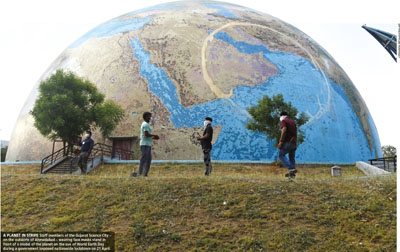REGIONAL OUTLOOK

SOUTH ASIA: POST-COVID OUTLOOK
Zulfath Saheed reports on how COVID-19 is affecting the region’s economic prospects
 South Asia faces a dire economic outlook on account of the unprecedented COVID-19 crisis; it is expected to experience its worst economic performance in 40 years, according to the World Bank.
South Asia faces a dire economic outlook on account of the unprecedented COVID-19 crisis; it is expected to experience its worst economic performance in 40 years, according to the World Bank.
As the ‘South Asia Economic Focus Spring 2020’ report released in mid-April notes, “the harsh reality of inequality in South Asia is that poor people are more likely to become infected with the coronavirus as social distancing is difficult to implement for them.”
It continues: “They also have less access to healthcare or even soap, are more likely to have lost their job and are more vulnerable to spikes in food prices.”
The unfolding economic crisis is being viewed as unique in many ways with the World Bank estimating that regional growth will fall to between 1.8 and 2.8 percent this year compared to 6.3 percent projected only six months prior. A sharp economic slump is anticipated for the region’s eight nations as a result of curbing economic activities, crumbling trade, and the added strain on finance and banking.

MAJOR DRIVERS This dire forecast for the region is founded on an analysis of several adverse impacts.
“South Asia finds itself in a perfect storm. Tourism has dried up, supply chains have been disrupted, demand for garments has collapsed, consumer and investor sentiments have deteriorated, international capital is being withdrawn and inflows of remittances are being disrupted,” the World Bank explains.
It elaborates that “on top of the deterioration of the international environment, the lockdown in most countries has frozen large parts of the domestic economy. Public banks… were at the centre of weaknesses in financial sectors that accumulated during recent years. However, during this crisis, they might be part of the solution by providing counter-cyclical lending to the most vulnerable parts of the economy.”
COLLECTIVE FUNDS As nations began to stand up and take notice of the coronavirus pandemic in mid-March, during a video conference of the SAARC heads of state and government, Indian Prime Minister Narendra Modi proposed a coronavirus emergency fund, which was set up in response to the global COVID-19 pandemic.
The initiative aimed to mitigate the risks associated with the coronavirus outbreak in the South Asian region. Other members of SAARC expressed their support for Modi and his proposal.
India announced that it would donate US$ 10 million as an initial contribution to support the initiative. And its prime minster stated that contributions to the fund by member countries would be voluntary. By mid-April, the emergency fund had accumulated more than 21 million dollars with a pool of contributions from seven member nations.
The Maldives, Bhutan and Bangladesh announced that they would contribute US$ 200,000, 100,000 and 1.5 million respectively, while Nepal and Afghanistan pledged one million dollars each. On 23 March, Sri Lanka too announced that it would contribute US$ 5 million and in April, Pakistan said it had contributed three million dollars to the fund.
INDIAN REGRESSION By early May, a handful of nations across the globe announced plans to ease restrictions put in place in the face of the coronavirus pandemic. This included India, which up until that point had implemented what was considered the lar-gest lockdown in the world.
Whereas India’s success in curbing the COVID-19 outbreak was attributed to its fierce lockdown, the dangerous contagion appeared to be spreading with the lifting of restrictions on citizens’ movements.
For instance, in a report filed on 7 May, The New York Times asserted that “the country is already regressing. The caseload is now doubling every 9.5 days instead of every 12 days. The daily death toll has shot up to more than 100 from a few dozen in mid-April.”
Nearly a third of India’s infections at the time were reported in urban centres such as Mumbai and New Delhi with officials voicing concern about not having the requisite resources to avoid an even larger outbreak.
INCOME STREAMS Financial concerns are among the most crucial for natives of South Asia in the face of the coronavirus pandemic with large swathes of the public identified as daily wage earners who have many mouths to feed but found themselves without sources of income amid the curfews and lockdowns.
Although accounts of widespread food shortages have not been reported, experts caution that a sustained COVID-19 crisis could in turn affect food security among vulnerable segments of the population.
The SAARC COVID-19 emergency fund could be used as a foundation to boost regional cooperation. In addition, South Asian nations would have to implement fiscal and monetary stimulus measures to moderate the long-term economic impact on the region, invest in underdeveloped healthcare systems and institute reforms focussing on pro-poor progress.





Leave a comment